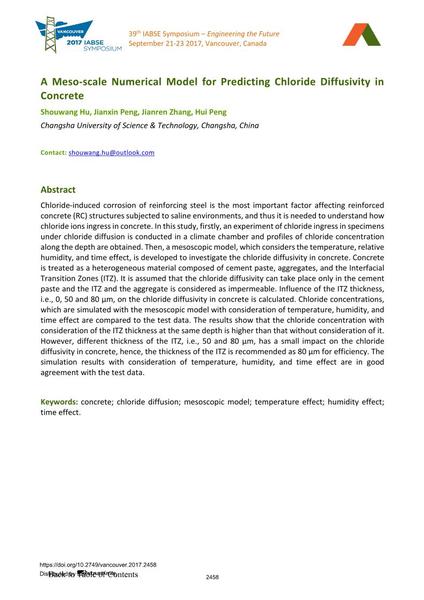A Meso-scale Numerical Model for Predicting Chloride Diffusivity in Concrete

|
|
|||||||||||
Détails bibliographiques
| Auteur(s): |
Shouwang Hu
(Changsha University of Science & Technology, Changsha, China)
Jianxin Peng (Changsha University of Science & Technology, Changsha, China) Jianren Zhang (Changsha University of Science & Technology, Changsha, China) Hui Peng (Changsha University of Science & Technology, Changsha, China) |
||||
|---|---|---|---|---|---|
| Médium: | papier de conférence | ||||
| Langue(s): | anglais | ||||
| Conférence: | IABSE Symposium: Engineering the Future, Vancouver, Canada, 21-23 September 2017 | ||||
| Publié dans: | IABSE Symposium Vancouver 2017 | ||||
|
|||||
| Page(s): | 2458-2465 | ||||
| Nombre total de pages (du PDF): | 8 | ||||
| Année: | 2017 | ||||
| DOI: | 10.2749/vancouver.2017.2458 | ||||
| Abstrait: |
Chloride-induced corrosion of reinforcing steel is the most important factor affecting reinforced concrete (RC) structures subjected to saline environments, and thus it is needed to understand how chloride ions ingress in concrete. In this study, firstly, an experiment of chloride ingress in specimens under chloride diffusion is conducted in a climate chamber and profiles of chloride concentration along the depth are obtained. Then, a mesoscopic model, which considers the temperature, relative humidity, and time effect, is developed to investigate the chloride diffusivity in concrete. Concrete is treated as a heterogeneous material composed of cement paste, aggregates, and the Interfacial Transition Zones (ITZ). It is assumed that the chloride diffusivity can take place only in the cement paste and the ITZ and the aggregate is considered as impermeable. Influence of the ITZ thickness, i.e., 0, 50 and 80 μm, on the chloride diffusivity in concrete is calculated. Chloride concentrations, which are simulated with the mesoscopic model with consideration of temperature, humidity, and time effect are compared to the test data. The results show that the chloride concentration with consideration of the ITZ thickness at the same depth is higher than that without consideration of it. However, different thickness of the ITZ, i.e., 50 and 80 μm, has a small impact on the chloride diffusivity in concrete, hence, the thickness of the ITZ is recommended as 80 μm for efficiency. The simulation results with consideration of temperature, humidity, and time effect are in good agreement with the test data. |
||||
| Mots-clé: |
béton
|
||||
